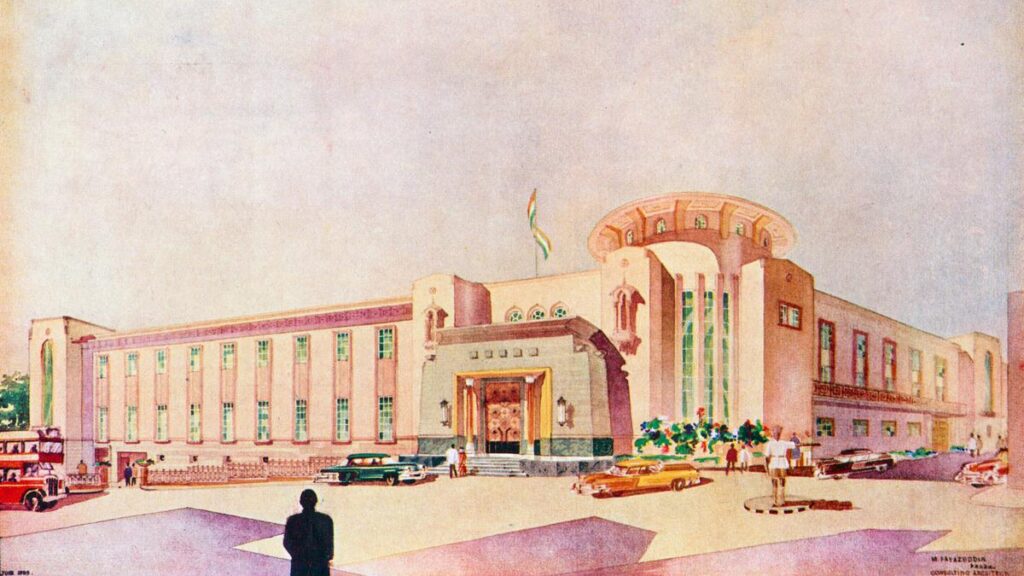Hyderabad is a city of Qutb Shahi domes, Nizam-era arches, British era colonnades and Indo-Sarcenic spires. Beyond these, there are areas where the architecture takes on a different character, offering arresting sights of buildings shaped by fluid curves, bold forms, and distinctive designs that stand out.
“These are Art Deco buildings that were part of the architectural movement that was born on April 29, 1925, in Paris. On that day, the ‘Exposition des Arts Décoratifs et Industriels Modernes’ opened in the centre of Paris. It spawned a movement known as Art Deco that influenced architecture, design of cars, railway engines, typography, drapes and even jewellery,” says architect Srinivas Murthy, who is curating an exhibition scheduled for April 29, at another Art Deco masterpiece in Hyderabad—the Raj Bhavan.
“As most of these buildings are not considered heritage, they are disappearing. Architecture is a layer of the city that we should be conscious of. It tells us about the social milieu and our evolution as a civilised society. Be it temples or mosques, all reflect the social, cultural, and political milieu. Every such layer is important as it tells about the time,” informs Mr. Murthy, who documented the Secunderabad Railway Station just as its facade was torn down to make way for a new building.
“The Art Deco was the choice of the wealthy and well-heeled in Hyderabad. When you see these buildings, you know where the wealthy lived,” he adds.
After 1925, the winds of Art Deco blew across the world with cities like Miami in the U.S.A. and Mumbai in India adopting it in a major way.
The art deco style was in vogue in Hyderabad for a few decades as can be seen with this building built in 1942 in the Abids area.
| Photo Credit:
Serish Nanisetti
However, the adoption of the art style in Hyderabad, in dozens of buildings, flew under the radar. They remained hidden in plain sight—the home of Patnys, Arya Samaj Mandir, Bachelor’s Quarters, Sheesh Mahal cinema hall, Sarathi Studios, Yakut Mahal and a host of them lining the R.P Road and some scattered in Begum Bazaar and near Charminar.
The Arya Samaj mandir on the RP Road, Hyderabad, built in 1947 is one of the art deco architectural masterpieces in Hyderabad.
| Photo Credit:
Serish Nanisetti
The sights are arresting, like a house in Barkatpura, or the grand Bank of Hyderabad (now SBI) building that was designed by architect Mohammed Fayazuddin.
Spread out on Mr. Murthy’s table is a photograph that was clicked from a spot in Banjara Hills beyond the Jalagam Vengal Rao Park, which shows three buildings: the Kohinoor (now GVK1), Aurora College and Panjagutta Masjid.
These Art Deco buildings in Hyderabad were designed by Mohammed Fayazuddin, Zain Yar Jung, Karl Malte von Heinz, Eric Marrett and other assistants of Mr. Fayazuddin.
“Art Deco had order, form and symmetry. The hand of the architect was free to draw a curve and let it bend back,” says Mr. Murthy as he swirls a line that looks like the bannister of the staircase in the Raj Bhavan.
“Most homes and buildings designed in the Art Deco style were built between 1930 and 1965. Ravindra Bharati is an Art Deco piece which had an arch behind the statue of Rabindranath Tagore. That [arch] may get restored soon,” he says.
While the architects were free to indulge in the curvy form, thanks to the flexibility and strength of concrete and iron, it also helped the ornamentation and decorative elements that became part of the Art Deco vocabulary.
This allowed elements like Chaitya arches, images of gods, vegetal patterns, Islamic architectural elements and artistic decorative patterns.
When Telangana Governor Jishnu Dev Varma saw an old image of the Raj Bhavan, he wanted to know why the view from the doorway had changed.
“The reason was the runaway encroachments. Between the Raj Bhavan and the Hussainsagar Lake, there were no houses or trees. With the rise of the colony known as Maqta, everything has changed,” says Mr. Murthy as he points to a photograph of a pillar in Raj Bhavan that has a small gap at the top.
The gap makes it appear as if the roof is floating.
A 100 years after the birth of an architectural movement in distant Paris, a few eclectic specimens survive, thrive in Hyderabad and can make ones day while travelling here in the Metro.
Published – April 28, 2025 04:40 pm IST
Source:https://www.thehindu.com/news/cities/Hyderabad/celebrating-art-deco-buildings-in-hyderabad-100-years-after-birth-of-architectural-style-in-paris/article69490744.ece

